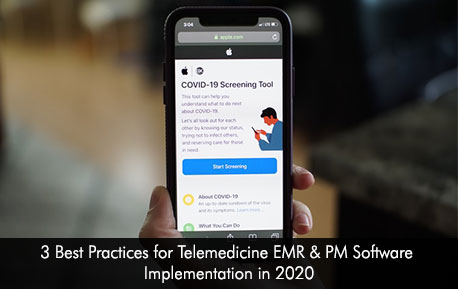If your practice is considering to implement a telemedicine software system and have limited experience with the telemedicine technology and program and this article will prove to be your perfect guide. Modern technology that supports remote patient monitoring such as video sessions and mobile communication devices has helped to empower clinicians to provide better care to patients who live in the outskirts and have mobility issues.
With the surge of the COVID-19 pandemic telemedicine software has been deployed by thousands of hospitals and clinics to support prompt diagnosis and treatment of patients. The United States of America is implementing new telemedicine tools to treat patients remotely amidst the outbreak. Any hospital facility or medical practice is bound to make mistakes an error while implementing telemedicine software solutions. To avoid these mistakes we have compiled a list of best practices that will help your practice overcome the problems related to telemedicine software deployment and let your organization stay on the right path.
Best Practices for Telemedicine EMR & PM Software Implementation
- Train your staff to use the new Telemedicine EMR & PM Software tools – Training is the first step to make sure that the software is used at its full potential. With many healthcare providers and staff members using the telemedicine platform for the first time, it becomes necessary that the users are trained to make use of the software system for their benefit. It is highly recommended that you chose a telemedicine software vendor that offers customer support and training material for you and your team members. The team should be first introduced to the new software tools and they should be allowed to explore it and hence get clarity in navigation.
- Marketing new Telemedicine EMR & PM Software services to patients – Once your staff is comfortable in using the software system the next step is to communicate the functionalities of the platform with your patients. For this, you must have a patient portal to share information with patients in the best way. The provider can send an email about new telemedicine services to patients this can include information like; the possible benefits of the new service, instructions to get started, and customer support. Patients are more likely to go to physicians who offer consultations over HD virtual sessions.
- Prioritize patient privacy and HIPAA Compliance – As a healthcare professional and a provider, you must consider the privacy of sensitive patient data. Before selecting a telemedicine software for your practice make sure that the vendor meets HIPAA Compliance for Meaningful Use and provides complete encryption of data that will be shared on the software platform. You would also need to create strong and secure links, which are easier to establish with HIPAA professionals. You must continue to monitor telehealth regulation changes and adjust accordingly. You can furthermore maintain privacy by only allowing authorized users to access confidential data and adapt a virtual private network (VPN) that ensures data protection on patients and the provider’s end.
EndNote
Before implementing a telemedicine software program you need to be sure to address any infrastructure challenges by mapping out all your clinical needs and also identify cost-saving opportunities. By defining your goals you will be in a better place to measure your success using the telemedicine program. If you implement the 3 best implementation practices mentioned above your telemedicine software will run smoothly and ensure that its maximum potential is realized.







